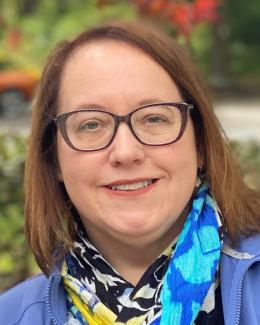Interdisciplinary work has been a hallmark of Julie Mitchell’s career, and it is a strength she expects to leverage in helping solve some big science challenges as she steps into the role of Deputy Director of the Biosciences Division at Oak Ridge National Laboratory (ORNL).
Mitchell will support existing research and plans to build new programs supporting bioenergy as well as crosscutting biomedical initiatives. Just a few days into her new job, Mitchell said she is looking forward to getting to know division staff and expanding ORNL’s footprint in quantitative biology.
Mitchell comes to the lab from the University of Wisconsin–Madison, where she was a professor of mathematics and biochemistry. Her own research interests involve working on projects at the interface of biochemistry, data science and high-performance computing. Her lab at the university developed predictive models for protein structure and interaction.
“I like a mixture of science in my work—biology, chemistry, physics, computing, and mathematics—a blend of things where I can gain depth and breadth and have a broad perspective,” Mitchell said. “There are areas of science where people can pick a single problem, and some mathematicians work more like that—they are narrow but deep in their work. I enjoy being able to gain expertise across different branches of science as part of my research.”
Her work to build quantitative biology at ORNL is expected to encompass the capacities needed for biofuels and other bioenergy efforts as well as the pursuit of biomedical science crosscutting projects, Mitchell explained.
Mitchell was an academically inclined young woman who enjoyed school and began her college career at San Jose State University as a business major. Mitchell quickly decided she wasn’t interested in studying money and turned instead to her favorite subjects of math and chemistry instead. Mitchell devoted her elective units to the study of art history and music—areas that still interest her.
She earned a B.A. in mathematics at San Jose State and then completed a Ph.D. in the same subject at the University of California at Berkeley. As she finished up her graduate studies, Mitchell realized she wanted to engage in applied science and began exploring application areas. “Someone suggested I look at the protein folding problem, and when I pulled up pictures of protein structures, I thought they were really beautiful. There were mathematical equations and interesting science that mixed chemistry, biology, computing, math, and physics, so I proceeded in that direction,” Mitchell said.
An appreciation for multidisciplinary work
Mitchell became the first mathematician hired into a postdoctoral research position with the La Jolla Interfaces in Science program. In her position at the San Diego Supercomputer Center at the University of California, San Diego, she worked on high-performance computing approaches to molecular docking. She later was hired as an assistant principal scientist at the center.
Mitchell has a lifelong love of programming, something she has been doing since the age of 15 and what she calls her favorite professional activity. Working at a supercomputing center was a natural fit for her interests, and a place to gain more advanced computing abilities. “It was a chance to take a new direction and to expand my skill set,” Mitchell noted.
Mitchell later took a junior faculty position at the University of Wisconsin-Madison, where her time was split 50/50 between the math and biochemistry departments. It was a first of its kind arrangement for the university, and Mitchell quickly secured tenure in both of those highly-ranked departments.
After 14 years at UW-Madison, Mitchell was ready for a fresh challenge when ORNL sought her out. The decision, Mitchell said, was made easier by the lure of ORNL’s high-performance computing capabilities and the opportunity to work on large collaborative projects. “The structure of the lab facilitates larger and more complex projects than are typically possible in a university environment,” Mitchell said. “We’re talking big science. It seemed a natural evolution to my career.”
The prospect of working at a national lab that also sits near a “charming city,” as Mitchell describes Knoxville, was a lure to the position. Mitchell is looking forward to kayaking, biking, and hiking in the region, and is already planning outings in Knoxville’s Urban Wilderness area. Her interest in art and music has continued, with a large collection of vinyl records and two vintage jukeboxes in her new living room.
“Madison and Knoxville have some parallels, including a vibrant downtown about a mile from a vibrant university, unique water features, and both have swarms of football fans. In Madison everything was red, and obviously here it’s orange,” Mitchell said.
ORNL is managed by UT-Battelle for the Department of Energy's Office of Science, the single largest supporter of basic research in the physical sciences in the United States. DOE’s Office of Science is working to address some of the most pressing challenges of our time. For more information, please visit http://energy.gov/science.




